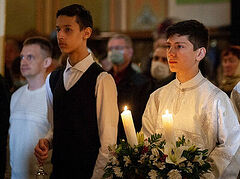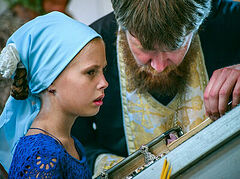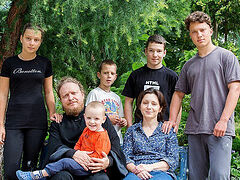Early childhood development is in vogue these days. It concerns different areas of a child’s life, including reading. One of the most common questions parents ask professionals is about when they should learn to read.
When my oldest daughter was five, a friend asked me if she could read. I said no. She knew most of the letters, but we didn’t try to put them into syllables yet. My friend raised her eyebrow high and said her son was three and was already reading.
It’s hard to get a rise out of me with things like that. But many parents are genuinely upset when they hear something like that and they start thinking their children aren’t up to par. Therefore, I’ll try to explain how a child’s brain works and when it makes sense to start teaching them how to read.
A child develops gradually, be it physically, emotionally, or intellectually. The stages of this development are logical and gradual: First, an infant learns how to hold his head up, and only later to sit and crawl, but not vice versa. It’s important for his safety, but it also allows him to harness new skills better and more easily.
The brain also develops gradually, but irregularly: The rate of development can decrease or increase for different kids at different times. And the left and right hemispheres of the brain develop differently, too.
The right hemisphere actively develops from age three to five. It’s responsible for perceiving whole images. Such development is stimulated by interacting with the surrounding world. A child observes, listens, touches, smells, handles various objects, and learns to perceive images in their entirety. At this stage of development, he gladly inspects letters, especially if they’re beautifully and brightly drawn, similar to objects he’s familiar with, like animals or people.
But for a young child, this recognition is simply a game. He doesn’t perceive a letter as a symbol denoting a sound. It’s simply a picture for him. That’s why many parents complain: “He knows the whole alphabet, but he doesn’t want to read.” He doesn’t want to because he doesn’t understand how to do it yet. And he doesn’t understand it because his brain isn’t ready for it.
He’ll be ready when his left hemisphere develops enough. It usually happens when children are five to seven years old. The left hemisphere is responsible for analytical tasks. This means the child begins to understand, for example, that a letter is the symbol for a sound. He analyzes his own and other people’s speech, compares it with the symbols, and sees how they correspond. Behind the letter, that is, a graphic symbol, a picture, he begins to see the sound. Over time, he understands how to connect these sounds into syllables, and syllables into words. In general, it happens when the child is six or six and a half years old.
If you set a goal of teaching letters to a three-year-old, it can be done. He’ll delight his grandmother and amaze guests with his knowledge of the alphabet. Only, his brain won’t be processing letters as sound symbols, but only as pictures. He memorized the pictures, so the letters “A,” “K,” or “U” are the same as a picture of a cat or a ball from his book.
And everything would be fine, but an incorrectly formed ability to read will linger on for a long time. Once he reaches the age of six or seven, he’ll be on par with his peers who just learned to read, but he’ll spend extra effort trying to grasp the meaning of the text. While his peers can read the symbol and perceive the sound behind it, his brain works on overload: At first, it processes the picture and then transfers it to another semantic field. It wastes energy and leads to a higher level of exhaustion, resulting in a decreased motivation to read.
If we simply needed to blend sounds into words to read, we would have mastered it earlier, easier, and quicker. But we know that, in practice, a single letter can stand for different sounds. When we read, our eye first looks for the vowels in a word and only then turns to the consonants. Because vowels determine if we should pronounce the consonants soft or hard.
Children with poor reading skills simply don’t understand what they’ve read—it takes all their brainpower to work out the letters
A child needs to master all this to be a good reader. And, mind you, we haven’t even touched on the semantic side yet—the understanding of a text. Children with poor reading skills simply don’t understand what they’ve read—it takes all their brainpower to work out the letters. In this case, it’s hard to talk about the benefits of a book, and even more so about enjoying the reading. And if you don’t enjoy it, you definitely won’t want to read.
In this respect, I often encounter the following scenario. Parents invest enormous effort, time, and money on early development. At two to three, the child knows the letters, and at five he can sound out syllables. By the time he starts school, he’s sick tired of endless learning and doesn’t understand the idea behind the text. He’s expected to excel in reading technique, but no one asks what the reading is about, or what he thinks about it, and how it relates to life. So, when the time comes and he’s asked to read and analyze, he has nothing to say. He feels only exhaustion and irritation. His peers can read at the same level, or even better, so he has no motivation whatsoever. He’s used to reading, but not to thinking about what he’s read. So why should he love books?
To understand whether your child’s ready to learn to read or not, you can do a simple test. Let’s assume he knows the letters well, he can recognize them on toy blocks or in an ABC book. Show him the same letters on a street sign, in a book, or draw it on a piece of paper. If he recognizes them, then his brain is ready to learn how to read. If not, there’s no need to rush. No matter how much you prod him, he’ll still develop at his own pace.
What your child truly needs is to listen to adults reading. There are several reasons for this. First of all, he gradually discovers the link between the book as an object and an interesting story. From the stage when “a book is a toy,” he moves on to the perception that it’s a special thing and it holds a hidden meaning that is uncovered every time his mom or dad picks it up: “The time will come and I will learn to do it on my own.” Secondly, according to the children’s author, teacher, and reading specialist Marina Aromshtam, for a child to want to read, we have to show him the possibilities of not only oral, but also written speech. Lastly, example and habit also play a huge role. When a child is small, what’s important to him is whatever’s important and interesting to us. This is when we as parents develop his tastes and outlook on life.
We learn to read to learn new things, something interesting, and to discover the world
There are two approaches to childhood reading. One is formal: The most important thing is to teach. The second one is about awareness: We learn to read to learn new things, to understand and absorb knowledge. And we want it to be interesting. We want to discover the world. The first approach, provided the adult is fully committed, can work, and a three-year-old will read to the admiring sighs of those around him. But if you ask him if he understood what he read, it’s pretty unlikely. The second approach has to do with text comprehension, which interest, reflection, and skill are based on. It’s all connected with certain stages of cognitive development. What we spent a ton of time and effort teaching a small child, an older preschooler would grasp much easier, and most importantly, with pleasure.
What makes us a reader isn’t the formal ability to put letters into words, but the ability to grasp what we read; to be amazed or outraged, to compare and analyze, to find parallels in real life and transform ourselves. These are complex processes, and we need to grow into them. Therefore, let the children run, jump, play, dream, and listen to what adults read to them. They’ll have time to master reading before school. All in due time.





